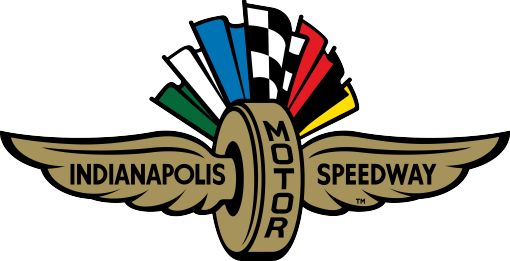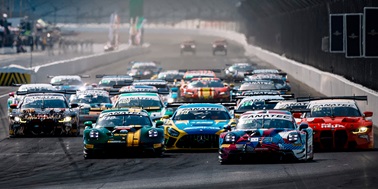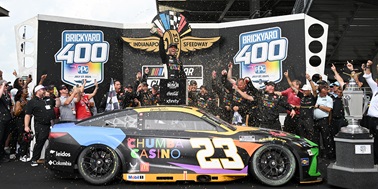Note: This continues a series of feature stories highlighting historic milestones and anniversaries honored in 2020 leading up to Legends Day presented by Firestone on Saturday, Aug 22 at IMS.
No one who attended the 1960 Indianapolis 500 will ever forget it.
For the entire last half of the race, two men—Jim Rathmann and Rodger Ward—dueled with each other, quite literally wheel-to-wheel, for the better part of two hours and with rarely any more than a few yards between them.
And this was long before the days of the "pack-up-behind-the-Pace Car" rule. During a caution period—and it would have had to be a fairly substantial on-track development for a "yellow" even to be called for—each participant was supposed to slow down on his own and maintain a constant interval behind the car in front of him until the green once again was displayed. Not all of them did so, however, and with two-way radios still a couple of decades away, it was the responsibility of a T-shirt-wearing pit board worker to keep his driver apprised of whether the driver behind him was complying.
The 1960 race began under cloudy skies with perhaps the most aesthetically pleasing start ever. Thirty-three Offenhauser-powered beauties, tightly packed in 11 rows of three, roared into the first turn as if they were sprint cars commencing a brief dash on a short track instead of embarking on a grueling marathon of 500 miles.
On the pole was the beloved Eddie Sachs, a voluble and entertaining crowd favorite who nevertheless was very serious about his racing. Next to him was the stoic and wily Jim Rathmann, who had finished second three times, including in two of the previous three Indianapolis classics. And starting on the outside of the front row was the equally canny Rodger Ward, the defending winner who had narrowly defeated Rathmann after a race-long duel in 1959.
Among those flooring their throttles behind this trio were Troy Ruttman, the 1952 winner, who after some lean years was mounting a spirited comeback; Johnny Thomson, the bashful pole winner and third-place finisher of the previous year; the powerfully built, cigar-chewing 1958 winner, Jimmy Bryan; gravel-voiced perennial challenger Tony Bettenhausen; and, further back in the field, the sensational rookie Jim Hurtubise, who just days earlier had astounded everyone by dirt-tracking his way around to break the qualifying records by well over 2 mph.
Indeed, grinning crew-cut newcomer Hurtubise had come within an eye-blink of registering the first-ever 150-mph lap. With pole sitter Sachs having raised the single-lap record on the opening day of qualifications to 147.251 mph, it had appeared as if the "magic 150" was still a year or two away. But the determined Hurtubise led the final-day qualifiers under rain-threatening skies to average 149.056 mph for his four-lap run, his fastest being turned at only 16 one-hundredths of second over one minute for an unbelievable 149.601 mph.
Just as had the late Jack McGrath on several occasions in the first half of the 1950s, Ward sped from the outside-front-row position and powered into the first turn ahead of his two colleagues. By the time the checkered flag fell just over three and a half hours later, the lead had changed hands an amazing 29 times, a record that wasn’t broken until 2012. And 14 of those 29 exchanges came during the second half of the race, exclusively between Rathmann and Ward in their virtually identical A.J. Watson-built Offenhauser-powered "roadsters."
Ward led the opening lap but was passed by Sachs for the next two. Then it was Ward for 15 more and Ruttman for six. Rathmann and Thomson also got into the act, and by the time the halfway mark was reached, the lead had been swapped no fewer than 12 more times.
The stage was set for the incredible second half.
Rathmann was leading, but Ward was right behind him. During the first of their three pit stops, however—back at Lap 43—Ward had stalled his engine. Rathmann had been able to get away in 31 seconds, but by the time Ward's portable electric starter had been inserted and the engine refired, his stop had extended to an excruciating one full minute. Ward then grimly began the task of trying to make up the lost ground. He was able to do it but at a cost, the master strategist Ward being well aware of the extra demand he was placing on his tires.
By the time the 350-mile mark was reached, Sachs, Ruttman and Bettenhausen all had been eliminated by mechanical failures, while everyone else either had been forced out or had fallen behind.
It was down to just Rathmann and Ward.
Once again, this was long before computerized scoring, digital readouts on steering wheels, spotters and two-way radio communication. All a driver had to help him then was a chalked pit-board message every minute or so, plus his very important intuition.
Back and forth they went, Ward for five laps, Rathmann for one, Ward for four more and Rathmann for another 11.
"I was mad at myself, because I thought I'd blown the race,” Ward said. “I had stalled on that first stop by pure brain-fade, and now I was paying the price. I had managed to catch up with Jim, but I knew I had really abused my tires in the process."
Just a few yards away, cagey three-time runner-up Rathmann, who knew as much about pacing oneself for 500 miles as anyone else in the field, was sizing up the situation. Ward was there for certain, but there was no point in throwing caution to the wind at this point.
"Jim was a very good friend of mine, and one thing I knew about him was that he would race you hard all day, but anytime he got to the front in a long race, his pace would start to slow down just slightly,” Ward said. “I would up and pass him, and by golly, here he would come again. Well, we knew from our pit board signs that we had several seconds on Johnny Thomson (running third), and so I decided to sit behind Jim for a while and see what happened. Well, sure enough, our pace began to fall off just slightly and here I was, running second and saving my tires, but at the same time feeling as if I was actually in control of the race!"
And then the pace picked up again.
So what had happened to that strategy?
A monkey wrench had been thrown into plan, the pit boards from both camps advising their drivers that Thomson was closing. Indeed, the bashful Thomson, driving the very same pink Lujie Lesovsky-built "lay-down" Offy with which he had battled this identical duo the previous year, had begun to carve away at the advantage. After 160 laps, he was only nine seconds behind.
Time to go!
Every time the Rathmann/Ward duo would come into view, the huge crowd would rise as one. Who would it be this time?
Ward led Laps 171 through 177 before giving way to Rathmann, who remained in front until Lap 182. Then it was Ward again for seven, followed by Rathmann for four more.
"I had been pacing myself as well up until that point while trying to figure out what I might do at the end if it was still close,” Rathmann said. “Should I try to fool Rodger in some way? It even crossed my mind about an old trick from my hot-rod days where you briefly slow down and hold up your hand as if you have a problem, then you stand on it! Not that I would have really done that, but I did learn that one the hard way from Andy Linden at Carrell Speedway when we were racing hot rods as kids!"
In the meantime, the concern of several laps earlier suddenly was no longer a factor. With a now-rough-sounding engine and the presence of telltale smoke, Thomson had been forced to slow down. And catching him was a pack comprised of short-track specialist Don Branson; motorcycle champion-turned-stock car racer-turned-Indianapolis 500 driver Paul Goldsmith and a wavy-haired, slow-talking rookie from Wichita Falls, Texas, named Lloyd Ruby.
But that pack wasn’t within reaching the lead duo. All of the strategies were out the window for Rathmann and Ward. The only thing left now was to race for the checker.
The crowd could hardly believe what it was witnessing.
On Lap 194, Ward went to the front yet again but on the 197th lap, it was Rathmann.
And that basically was it. There would be no more lead changes. WARD WAS SLOWING DOWN!
What could have happened? Was there an engine problem? Was he low on fuel?
No, it was tire wear. White cords were beginning to show through on Ward's right front and while many a driver would have come in for an emergency stop at this point, Ward knew that to do so would cost him several positions. Thousands upon thousands of miles as Firestone's chief test driver told him that he could slow down, and with a now-comfortable advantage over the pack which followed, he could still baby it home to second.
And that is precisely how it worked out:
Ruby, who was literally within yards of overhauling the fading Thomson for third, was forced in with only seven laps remaining for fuel and tires. Goldsmith and Branson, directly behind him, made short work of Thomson but were now three minutes in arrears of Rathmann and Ward.
Rathmann cruised on to the checkered flag, averaging a record 138.767 mph, and just over 12 seconds later—the widest margin between first and second all day—came Ward, slowed considerably and running next to the inside wall with lapped cars passing him easily to his right.
Rathmann was already rolling down toward Victory Lane after a "cool-off" lap when Goldsmith came across in third, holding Branson at bay by half a second. Thomson, his face, helmet and uniform blackened, grimly hung on for fifth, with steadily running Eddie Johnson making it home just ahead of Ruby, whose misfortune on this day was merely a forecast of what was due to befall this outstanding driver for the next two decades.
"What happened to Ward?" were Rathmann's very first words when he came to a stop. He received a variety of replies, mostly "Ran out of gas" and "tires."
"I knew it had to be tires," he said later, "because I was getting down there, as well."
For chief mechanic Takeo "Chickie" Hirashima, it was a double victory. Not only had Chickie prepared Rathmann's engine by himself, but he had done Ward's, as well.
Ward, who contended for the rest of his life that this was his greatest race—ranking it even ahead of his two victories—sportingly gave much credit to Rathmann, saying, "We were beaten fairly and squarely by a great race driver."
At the victory banquet the following evening, master of ceremonies Fred Agabashian, the retired "500" driver who had partnered with Sid Collins on the radio broadcast the previous day, got a huge laugh when he referred to Rathmann and Ward as "co-winners."
It was an especially rewarding victory for Rathmann, quite apart from the fact that he had just avoided becoming a four-time runner-up. Not only had he been responsible for talking first-time car owners Kenny Rich and Paul Lacey into the forming of this team just a few months earlier, but he and Hirashima had even gone out to Watson's shop in Los Angeles together to pick up the freshly completed car, towing it back to Indianapolis on an open trailer behind a station wagon.
There have been many wonderful races since then, and some unbelievable finishes, but there has, quite simply, never, ever been a sustained two-man battle to compare with this one.




